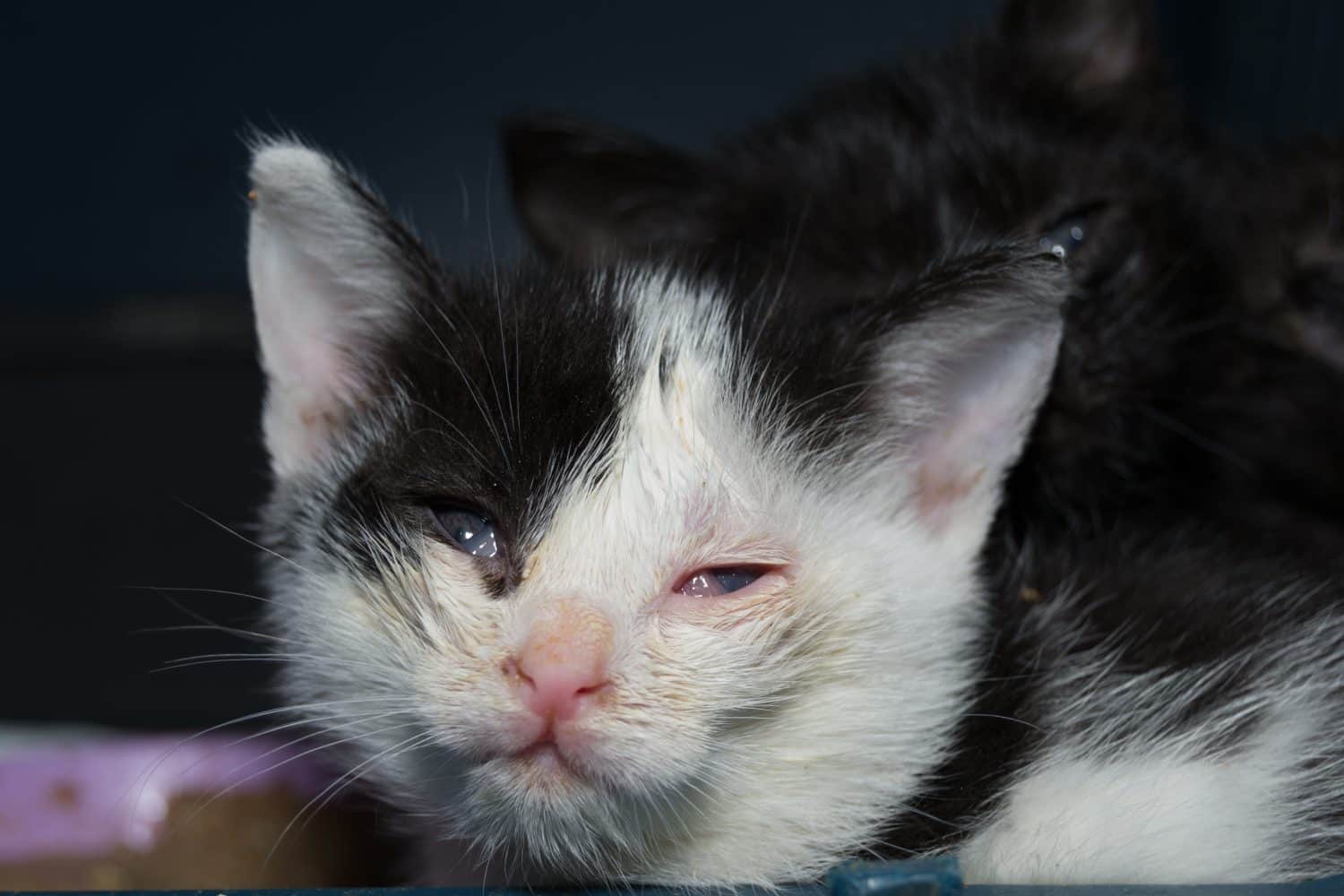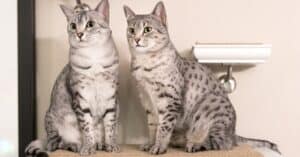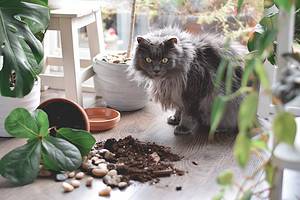Your cat’s eye is looking funny. Maybe it’s just a squint, maybe it’s watering, or maybe it’s completely shut. There are different reasons why your cat may be responding this way, and one possibility is a corneal ulcer. Learn about corneal ulcers in cats, including causes, symptoms, and treatment!
What Is a Corneal Ulcer in Cats?
Your cat’s eye is made up of various structures, some deeper, closer to the optic nerve, and some that are just behind the cornea. The cornea is the transparent layer on the surface of the eye. Behind the cornea is your cat’s vitreous humor, which maintains the shape of the eye.
Then there’s the lens, posterior chamber, iris, and finally the pupil, which dilates and contracts depending on light and focus. The cornea protects these different layers, keeping out any debris or germs. But that’s not all. It also assists with your cat’s vision, as it controls how much light gets into the eye. A corneal ulcer is a wound on your cat’s cornea. Sometimes, it’s a minor scratch. In severe cases, it can be a large wound that sends intense pain signals to your cat’s brain.

Corneal ulcers may be superficial, healing within a few days. However, they may also be quite deep and may require surgery.
©Todorean-Gabriel/Shutterstock.com
Corneal Ulcer in Cats: Causes
Trauma
The causes of corneal ulcers in cats vary but one of the most common causes is trauma. A fight with another cat, a bump up against a furniture corner, or even a self-inflicted scratch to the eye can result in a corneal ulcer.
Chemical Burn
Another cause of a corneal ulcer could be a chemical burn. This may occur if you bathe your cat with an irritating shampoo and it gets into their eye, but it could also happen in homes where there is construction and drywall dust makes its way into your cat’s eye.
Infections
If your cat has developed a viral or bacterial infection, this could also lead to a corneal ulcer. This is often seen with recurrent feline herpes virus (FHV).
Ingrown Eyelashes
Another cause for corneal ulcers could be ingrown eyelashes. When eyelashes grow inward, they irritate your cat’s cornea, causing small abrasions. Left untreated, corneal ulcers can develop further, causing blindness and maybe even loss of the eye.
Corneal Ulcer in Cats: Symptoms
Rubbing the Eye
If your cat has a corneal ulcer, it’s a very painful condition. You’re going to notice several different symptoms. One of the most common is your cat rubbing their eye repeatedly. It’s like they have something stuck in their eye and they’re trying to get it out.
However, continuous rubbing of the eye can further exacerbate a corneal ulcer so it’s vital that you get them to a veterinarian right away to confirm whether or not you are dealing with a wound. The earlier you detect a corneal ulcer, the faster you can help your cat heal.

If your cat has a corneal ulcer, you may notice persistent rubbing of the eye. If it is a corneal ulcer, rubbing the eye could exacerbate the injury.
©Volcko Mar/Shutterstock.com
Discharge
Another symptom of a corneal ulcer is discharge. It may just look like your cat’s eye is watering so the discharge may be clear. But the discharge may also be cloudy.
Squinting
When your cat isn’t fussing with its eye, it may just be squinting. Corneal ulcers are painful, and your cat may be trying to protect its eye, responding instinctively by squinting and using its third eyelid (nictitating membrane) and top and bottom eyelids to protect the injured cornea.
Cloudiness
Just like the discharge may be cloudy, you may notice some cloudiness over your cat’s eye. Smaller abrasions in the cornea are not easily perceptible with the naked eye so if cloudiness is not present, it doesn’t mean there’s no corneal ulcer. There could still be a wound that requires veterinary assistance to detect.
Inflammation
Another symptom you may notice is inflammation of your cat’s eye. This could look like a reddish or pinkish color around your cat’s eye and is typically present in conjunction with several other symptoms, including squinting, discharge, and sometimes cloudiness.
Rapid Blinking
As your cat deals with a corneal ulcer, it may fuss with its eye and may blink rapidly due to the pain and discomfort.
Tightly Closed Eye
When your cat is experiencing severe pain due to a corneal ulcer, fussing with it or rapid blinking may not be enough to help ease the discomfort. Your cat may just want to completely shut its eye and keep it closed. This may be the response that brings even an ounce of relief.
Types of Corneal Ulcers in Cats

Cats with corneal ulcers may also develop conjunctivitis, which is when the pink membrane of the eye is inflamed.
©Todorean-Gabriel/Shutterstock.com
Before veterinarians can proceed with treatment, they first have to confirm the corneal ulcer. Dr. Colleen Wallace, a cat-only vet at the Cozy Cat in Raleigh, NC, explains the process required for the diagnosis of a corneal ulcer, “We stain the eyes with fluorescein stain, which will remain in damaged tissue but not on a healthy cornea. It causes the ulcer to turn green and then is easy to visualize.”
Once a veterinarian has a good visual, they can determine whether your cat is dealing with a corneal abrasion, a corneal ulcer, or a descemetocele. A corneal abrasion is a superficial injury and the simplest to treat of the three. Your cat usually heals within three to five days. A corneal ulcer is more serious as the injury isn’t superficial. It is a wound that extends into the deeper tissue of your cat’s eye.
A descemetocele is worse than a corneal ulcer as the injury has penetrated through the entire corneal layer, which then exposes the Descemet’s membrane. If your cat is dealing with a descemetocele, it’s a critical condition that may lead to irreparable damage. Depending on the type of ulcer your cat has, your veterinarian determines the type of treatment.
Treatment for Corneal Ulcer in Cats
Pain Medication
Part of the treatment plan for corneal ulcers involves pain management. Typically, veterinarians prescribe atropine because it is a long-lasting pain medication that can be used every 12 to 48 hours. But this medication dilates your cat’s pupil, which means your cat will be especially sensitive to light.
Atropine may also cause excessive salivation after application but that’s only because the medication drips through the tear ducts and ends up in your cat’s mouth. The taste of this medication is exceptionally bitter, which is what causes excessive salivation. Other pain medications may also be administered like gabapentin instead of atropine, but you can determine that with your veterinarian.
Antibiotic
In addition to pain management, your cat will need an antibiotic. Your vet may prescribe antibiotic ophthalmic drops or an ointment. The antibiotic also helps to relieve some of the pain and helps to prevent infection. If you’re using drops, you’re going to be applying them every couple of hours but if you use an ointment, it lasts a bit longer, so you won’t need to apply it as frequently.
Elizabethan Collar
While your cat’s eyes heal and you continue administering the pain medication and antibiotic, your cat will need to wear an Elizabethan Collar. This ensures that your cat cannot access its eye and further injure the area.
Surgery
In some cases, your cat may require surgery. If your cat is dealing with a severe corneal ulcer like a descemetocele, the surgeon may suture your cat’s eye closed for a couple of days to allow the injury to heal. Ultimately, each case is a little bit different, and your veterinarian is the one who will suggest the appropriate course of treatment.
The photo featured at the top of this post is © dimarik/iStock via Getty Images
Thank you for reading! Have some feedback for us? Contact the AZ Animals editorial team.







